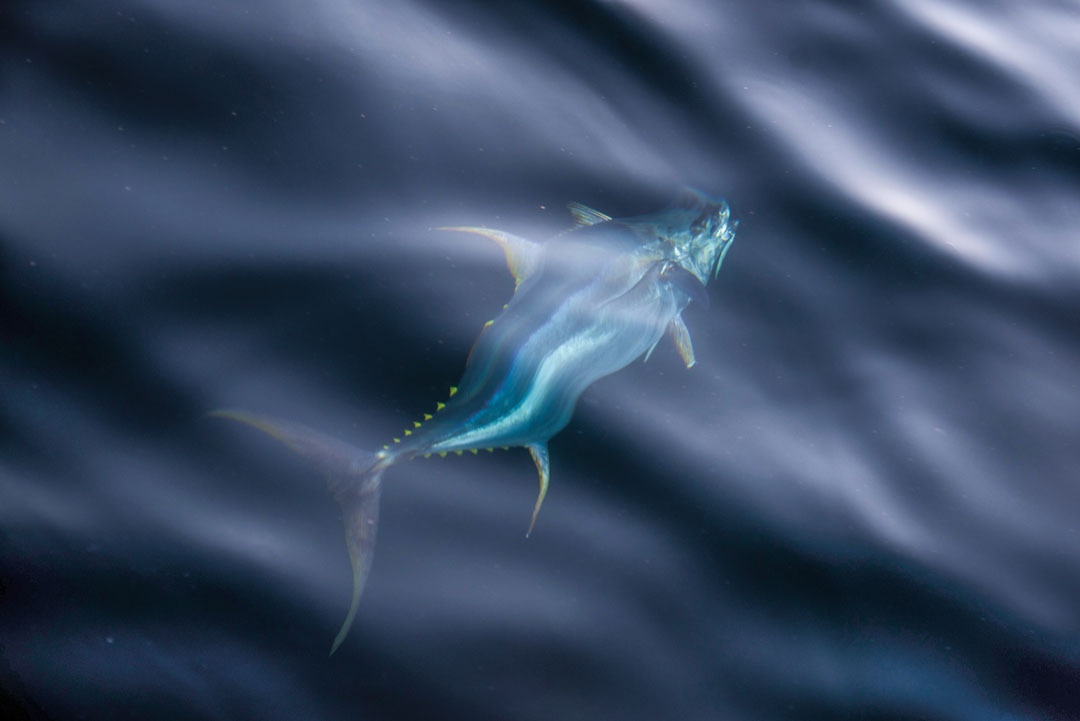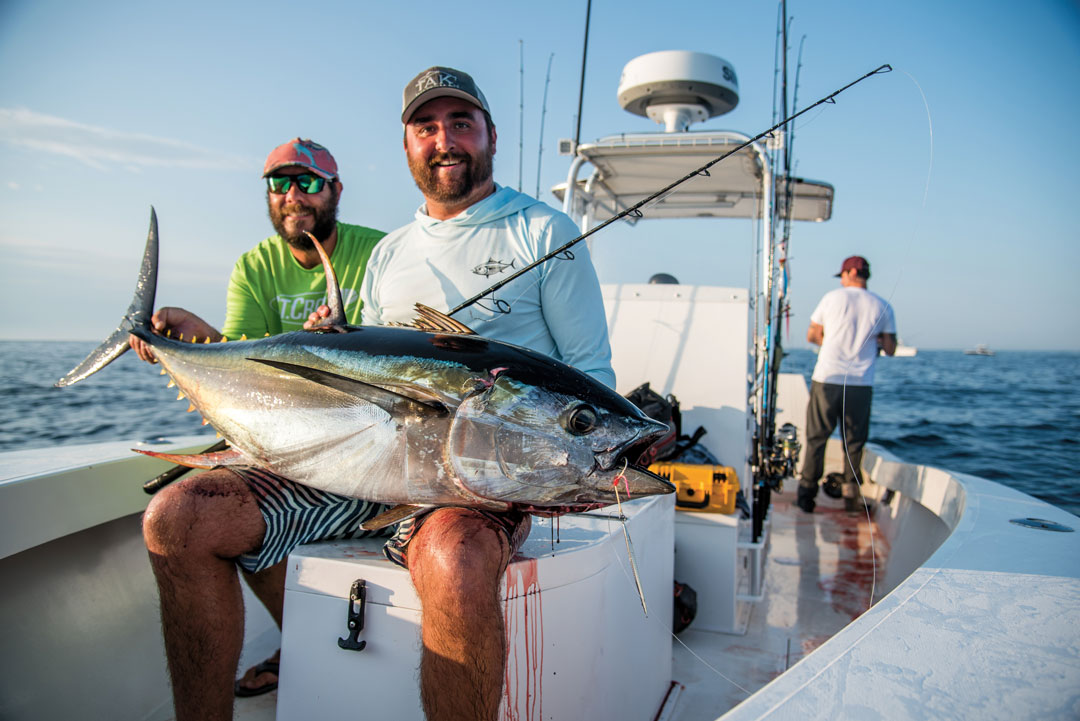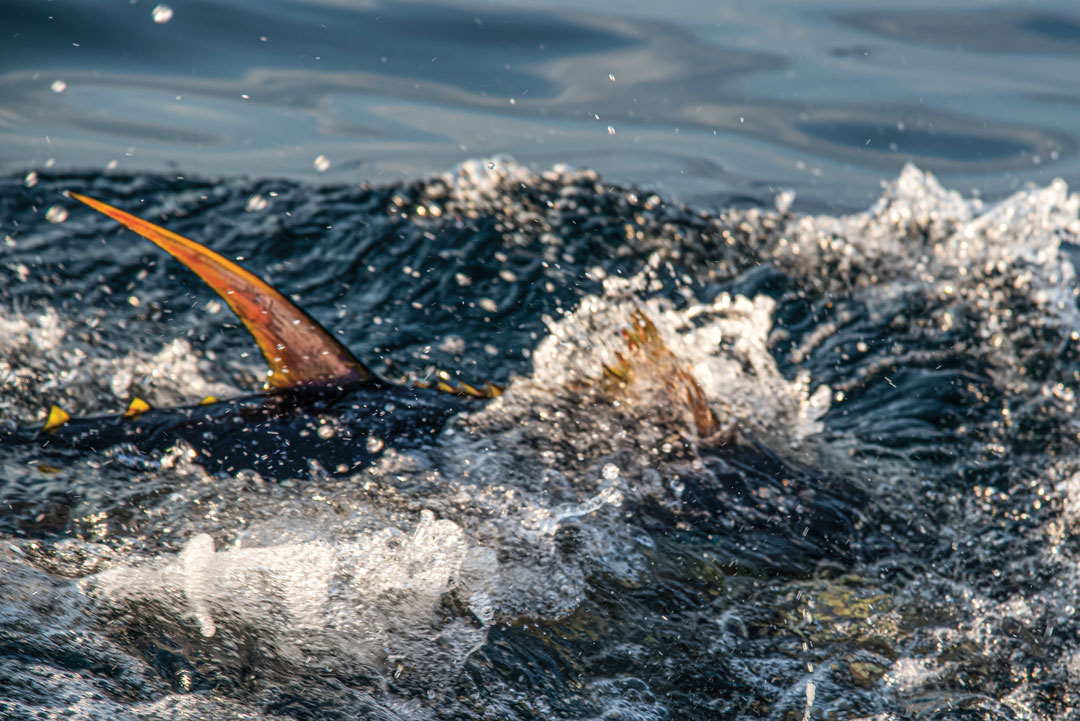Light-Tackle Yellowfin Tuna
When warm water brings yellowfin tuna inside the canyons, anglers greet them with light tackle, jigs, and poppers.

There’s lightning in the distance and we’re riding toward it, but Captain Rob Radlof of Waterman Charters seems unfazed. In the pre-dawn darkness, the occasional pinkish flash illuminating the clouds gives the morning a “riding into battle” feel. It’s a scene that would pair well with Led Zepplin’s “Immigrant Song,” I think, as the 27 Conch bounds over the gentle seas toward an undersea hump some 45 miles offshore. There, schools of yellowfin tuna had followed a spur of warm water off the Gulf Stream, bringing them within striking distance of boats from Barnegat Inlet to Metro New York.
As the lightning begins to wink out, new lights appear on the horizon—a staggering number of boats. As we approach the fleet, aside from its size, I’m amazed by how few of them are equipped for trolling.
(Note: On The Water is reader-supported. When you buy through links on our site, we may earn an affiliate commission.)

In the early 2000s, when I got my first taste of tuna fishing thanks to an invite from a family friend, we encountered a similarly large fleet on the Hot Dog Lump out of Cape May. Back then, every boat was outfitted with large reels, 30- and 50-pound-class Penn Internationals and Shimano TLDs, strapped to thick rods with roller guides. Most of the boats in this fleet, including Radlof’s, have no conventional reels at all. Spinning reels, primarily Shimano Stellas, Twinpowers, and Saragosas in sizes 8000 to 14000, are the most prevalent models in the fleet.
I’m well aware of tuna fishing’s spinning-rod revolution—how more anglers today prefer the more intimate experience of dropping jigs or casting plugs for tuna—but this is my first time seeing its full scale. While the boats touting “bass tackle” would have been the outliers just a decade ago, it is now the handful of boats trolling the fleet’s periphery that seem like the ones bucking the trend.
As Radlof maneuvers the boat through the fleet, looking for signs of tuna life outside the concentration of boats, his radio crackles with news from Captain Adam Sherer, Radlof’s friend and partner in Waterman Charters. The anglers on Sherer’s boat (also a Conch 27) have doubled up on poppers. The tuna are here, and they are hungry.
Radlof finds what he’s looking for on the edge of the fleet—a big concentration of storm petrels, more commonly called “tuna chicks” in the Northeast’s angling circles. The storm petrel is a small bird, no larger than a robin, that appears to tap dance over the water’s surface. The name “petrel” comes from this behavior, an homage to Saint Peter and his walk on the water of the Sea of Galilee. Petrels feed on, among other things, baitfish scraps and oils that float to the surface when tuna are tearing through schools below; hence their importance to tuna-seeking captains.
With the boat out of gear, the crew selects their rods. On board with Radlof are Tommy Wyzga and Shawn Matthews. The three of them move about the boat with the familiarity of a crew that’s been fishing together for years. The ride out has been full of stories from their shared fishing history, and as dawn breaks over the Atlantic, I hope we’re about to add one more to the library. Rob hands me a Shimano Grappler and Twinpower combo rigged with a white Madd Mantis Popper. “Big pops, long pauses,” Rob says, as he grabs a rod rigged with a jig to work the lower half of the water column.
Matthews joins me on the bow, casting a popper, and Wyzga settles into the portside stern corner to work jigs.
We can see boats in the distance in various stages of fighting and landing tuna, and the consensus over the radio is that jigs are outproducing poppers. Matthews makes the switch, but because I am too in love with the idea of a surface-smashing yellowfin, I stick with the popper. However, my resolve evaporates when Wyzga exclaims from the stern, “Oh! He punched it.”

A yellowfin, just off the bottom, has taken a swing at Wyzga’s jig, a slender sand-eel imitation called the Streaker made by the Australian company, Nomad Lures.
In recent seasons in New Jersey, the primary food of any tuna inside the canyons has been the sand eel. This made the Streaker, the top-selling tuna jig—with local shops selling out as soon as the jigs arrive. Differing from the standard diamond jig, the Streaker has one flat side that adds to its action on the fall and also while being worked through the water column. On the packaging, it’s touted as a “high-pitch” jig; that is, a jig intended to be fished through the water column with a fast retrieve.
In 2021, however, sand eels were scarce off New Jersey’s “midshore” lumps. In their place, massive numbers of squid moved in.
While the same slender jigs proved productive despite the switch in baitfish, the more effective colors had changed. In most years, the natural sand-eel color, a combination of green/olive/brown/silver, got the most bites. By the middle of the 2021 tuna season, however, it was clear that pink, white, and blue/pink were the hot colors.

The retrieve Radlof and crew use involves short, fast lifts of the rod that correspond with a single, complete turn of the reel handle. It takes a bit of coordination to get it going—think of patting your head and rubbing your belly at the same time—but once you get the cadence down, it’s pretty simple. Done right, the jig should look like it’s zigging and zagging toward the surface, pausing for half-a-heartbeat between each dart, which is precisely when the tuna strike. However, according to Radlof, it’s almost as common for a yellowfin to take on the initial drop, which is exactly what happens to him a few moments after I’ve switched to a jig.
He quickly gets the fish within sight, but the tuna finds a second wind when it sees the boat. It sends Radlof on a few laps around the Conch 27, taking short bursts of line from the Stella 10000, before it comes within range of a gaff-wielding Wyzga.
With the fish on ice, we’re all working jigs again, and I’m struggling to find the cadence. Within the next 15 minutes, Wyzga misses a second fish, Radlof swings and misses on one, and Matthews goes to his tackle bag to switch things up.

Matthews has done the most lure-switching of everyone on board. He’s gone from popper to metal jig to soft-plastic RonZ, then back to a smaller metal. To deploy the 80-gram jig (having downsized from the 120-gram Radlof, Wyzga, and I are using), he’s scaled down his tackle as well, going with a 5000-size Shimano Twinpower and a rod that seems sized for false albacore rather than yellowfin. “Rob loves when I bring the light gear,” Matthews later joked.
The benefit of the lighter gear is that it often works the lures, especially smaller ones, more naturally, and for the typical New Jersey inshore yellowfin, which range from 20 to 40 pounds, Matthews’ setup is more than capable.
Right near the bottom, a tuna snaps up the smaller jig, and the drag begins to sing. Within a few seconds, it’s clear this isn’t one of the “typical” yellowfin.
A side effect of the influx of squid this season, Radlof says, is that it brought larger yellowfin inside the canyons. Throughout the summer of 2021, numerous anglers claimed to have caught yellowfin that crested the 100-pound mark. That’s a big yellow for anywhere in the Northeast, but especially big for the inshore grounds.

As the yellowfin is turning up the heat on Matthews, so does the rising sun. He puts as much pressure on the fish as the 40-pound-test braided line can handle and begins inching the fish toward the boat. As we see color, the most striking part about the fish is the length of its “sickle fins.”
In some parts of the yellowfin’s range, the second dorsal and anal fins grow so long that they extend almost to the tuna’s tail. Fish with this characteristic earn the moniker Allison tuna, and for a while, they were believed to be a different species. Allison tuna are more common in the Gulf of Mexico and Pacific yellowfin populations, but it’s not unheard of in the Northeast. This tuna’s fins don’t quite reach Allison status, but it’s the longest set I’ve seen on a yellowfin in person, and when the sickle pierces the grease-calm surface, the whole crew is awestruck by the sight.

The fish stays on the surface for a bit, but remains out of gaffing range. It then sounds and begins making wide circles, its fins skimming the surface at the far side of the circle, swimming well below the boat on the near side. Matthews is pouring sweat by the time Radlof lunges with the gaff, but the tuna gets a second wind and peels off all the line Matthews had gained through the fight.
Matthews taps Radlof for a set of fresh arms, and then chugs down some water. The mid-July sun has begun to flex its muscles, and the fight with the tuna has passed the 45-minute mark. However, the fish is wearing down as well, and within 15 minutes, Wyzga and Matthews both swing gaffs and end the fight, bringing aboard 90 pounds of New Jersey inshore yellowfin.

Pictures are taken, the tuna bled out and hung over the side on a tail rope, then the jigs are dropping again. Wyzga gets a couple more whacks, but the hooks fail to take purchase. I still feel like I’m doing the Funky Chicken rather than properly speed-jigging, but I finally get positive feedback from below. The hit isn’t like the thump of a striking bass or bluefish; instead, the jig is simply stopped in its tracks. The rod bends, a single click of drag lets out, and the hook pulls free. The feeling of finally getting the jigging down provides almost as much satisfaction of actually catching the fish.
By that time, word on the radio is that the bite is slowing down. The few boats still hooking up are doing so on live bait, mainly spot (a small member of the drum family) sent right to the bottom.
We ride back on calm seas under clear skies, conversation ranging from pontification about what the rest of the season might bring to the usual good-natured ribbing you’d expect from a boat full of happy fishermen returning with a cooler full of tuna.

Finding Midshore Yellowfin Tuna
The yellowfin tuna begin making their appearance at New Jersey’s midshore tuna grounds around the fourth of July, Radlof says, but their arrival has much more to do with when and where an eddy of warm water pushes off the Gulf Stream. Water temperatures of 75 degrees or more are necessary to bring the tuna in, but as long as the bait remains, the fish will linger in temperatures down to the mid-60-degree range.
• Book a trip with Captain Rob Radlof and Waterman Charters
These fish are structure oriented, looking for bait over the lumps from 40 to 60 miles out, but yellowfin also orient to “living structure.” Anglers regularly find yellowfin hanging below schools of rays, pods of dolphins, or shoals of skipjack tuna.
In most of the recent seasons, tuna inside the canyons, both yellowfin and bluefin, were keyed in on sand eels, but in 2021, sand eels were scarce, though squid were abundant. Radlof saw squid from 2 to 10 inches long, and the yellowfin greedily ate all of them. As a result, squid draggers were nearby, indicating squid were in the area and that tuna would likely be cashing in on the free lunch provided by the boats’ discards.
Leave a Reply